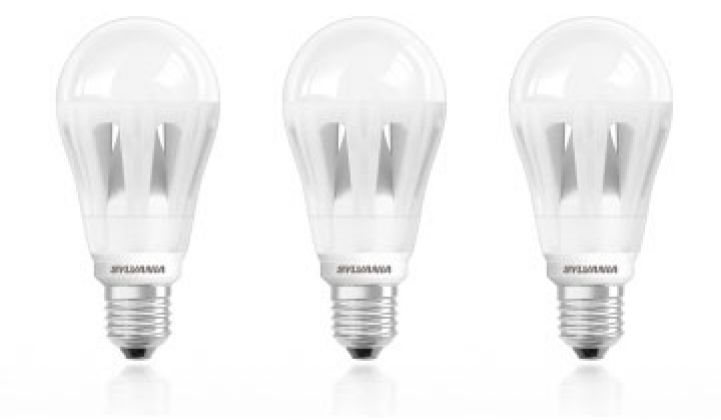The LED market is becoming like lettuce. Your lead is good for a day, but soon begins to wilt.
Osram Sylvania, one of the largest lighting manufacturers in the world, said it would come out with an LED bulb in August that emits 810 lumens, or about as much light as a 60 watt incandescent bulb. The bulb will consume only 12 watts. Osram also said it would have a 75 watt equivalent in 2011.
"This will last twelve times longer than an incandescent bulb," said spokeswoman Stephanie Anderson. "We are working to make this product affordable for most purchasers."
Meanwhile, Lighting Science--which announced earlier in the week that Home Depot has started selling its LED bulbs--said it will come out with a 770 lumen, 9 watt LED bulb that will come with a suggested retail price "in the low $30 range."
The lumens-per-price ratio is the key here. For years, LED makers have said that the solid state lighting would take off in homes and commercial buildings when they could sell lumens for pennies. Osram is being vague on the price but it says the bulb will be "affordable" and in line with a 40 watt equivalent/$30 LED bulb is sells now. That indicates a $40-ish price in my mind, for the 60 watt equivalent. Thus, Osram's bulb will likely sell for around five cents a lumen. Lighting Science has it down to 4 cents. (For an overview of the modern lighting market, click here.) Alan Salzman, managing director of VantagePoint Venture Partners, recently said that utilities could start giving away LED bulbs to consumers once they hit $20: the energy saved would allow them to postpone building new power plants and make up for the cost of the bulbs. Lumens would cost 2.5 cents in a $20, 800 lumen bulb.
In other words, the industry seems really close to the point of no return.
General Electric, Panasonic, Lemnis Lighting and others have announced or already released bulbs in the $40 range. These bulbs, however, only emit 450 to 500 lumens, or as much as a 40 watt bulb. I've been testing one of these at home and, believe me, you notice the difference between a 40 watt and a 60 watt right away. While many 40 watt equivalent LED bulbs will get sold, the 800 lumen range bulbs will become the de facto standard.
Philips announced a 806 lumen, 12 watt LED bulb at LightFair yesterday. The Philips bulb comes out a few weeks after Osram, but will sell in the $60 range, or around 50 percent more. Will Philips cut their prices? No doubt. GE, Panasonic and the others, meanwhile, will face the tougher challenge of increasing their performance. (Side note: most of these bulbs have a color temperature or tone around 2700 Kelvin, the standard for consumer bulbs.)
How are manufacturers cutting prices so rapidly? They are likely cutting margins to gain market share and solidify a position. Back in 2008, a 60 watt equivalent bulb cost around $90 and a dimmable 100 watt bulb sold in the $360 range. A year later, manufacturers in Japan were touting $40 40-watt equivalent bulbs. Mass manufacturing and technology advances are no doubt helping, but that would be an incredibly fast pace for technological advances. Warner Philips at Lemnis told us last year that margins would likely come down.
Prices will also be helped in their downward trajectory by leveraging one of the tried-and-true techniques of the chip industry: integration. Just as Intel and AMD integrated math processors into microprocessors and graphics chips into chipsets, LED makers will add things like motion sensors and smoke sensors into their products. LEDs are chips, after all, and the shrinking dimensions of transistors leaves extra room on the silicon substrate for more functionality. Redwood Systems has talked about linking temperature and other sensors into its LED networks. Osram showed off a gadget called the Musiclite at LightFair: a combo LED fixture and speaker.
With declining prices, expect mergers and acquisitions. Philips has spent over $5.4 billion since 2005 on snapping up companies like LED specialist Color Kinetics. Last year, Philips bought two smaller companies as part of its ongoing strategic push to move away from selling bulbs and move toward the sale of complete light fixtures.
While LED start-up Bridgelux has managed to raise enough money to build its own chip fabrication facility, many lighting start-ups don't have that kind of cash on hand to survive the shift in the industry from science experiments and demonstration projects to mass manufacturing and selling. Think of all the sales reps you'd need just to hit up Target, Lowe's, and other big box retailers to hawk your bulbs. Start-ups will have trouble getting the necessary heft. Luminus Devices has raised over $100 million but a good portion of that money has already been spent: the company recently had to undergo a "restart" or reorganization. The large, established manufacturers, meanwhile, need fresh ideas and intellectual property. General Electric's bulb revolves around an LED from Cree.
Although low prices will help drive adoption, it won't likely be everything. Performance will make a huge difference in which companies do well. An oft-cited metric in lighting is that one hour of productivity lost due to bad lighting will equal the amount of money saved by consuming less power. Consumers are also highly sensitive to color temperature (or tone) in bulbs. Consumer surveys show that most still prefer the warm, yellowish light of incandescent bulbs to the bluish "Alien Autopsy" tone of older LEDs. Most major manufacturers have managed to develop phosphor coatings that turn that bluish tint to a warm white, but word-of-mouth and reviews will determine who wins and loses.
Looks matter too. Osram deliberately tried to get its LED bulb to look as much as possible as a conventional bulb. It's the one in the picture.
"Consumers don't want ugly bulbs," she said. "There are some wild bulbs out there."



